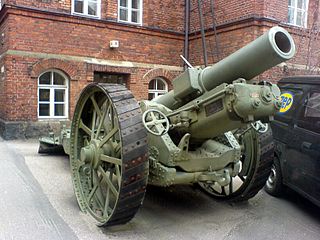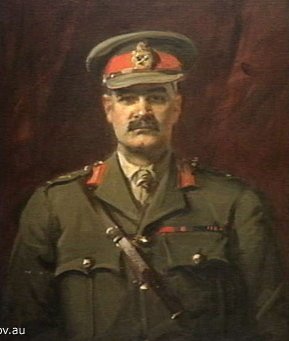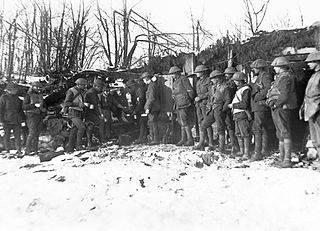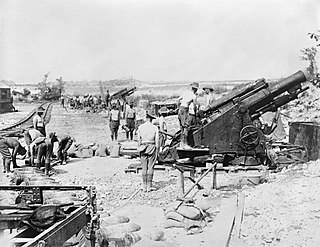
The Royal Regiment of New Zealand Artillery is the artillery regiment of the New Zealand Army. It is effectively a military administrative corps, and can comprise multiple component regiments. This nomenclature stems from its heritage as an offshoot of the British Army's Royal Artillery. In its current form it was founded in 1947 with the amalgamation of the regular and volunteer corps of artillery in New Zealand. In 1958 in recognition of services rendered it was given the title the Royal Regiment of New Zealand Artillery.

The BL 8-inch howitzer Marks VI, VII and VIII were a series of British artillery siege howitzers on mobile carriages of a new design introduced in World War I. They were designed by Vickers in Britain and produced by all four British artillery manufacturers but mainly by Armstrong and one American company. They were the equivalents of the German 21 cm Morser 16 and in British service were used similarly to the BL 9.2-inch howitzer but were quicker to manufacture and more mobile. They delivered a 200 lb (91 kg) shell to 12,300 yd. They had limited service in the British Army in World War II before being converted to the new 7.2 in (180 mm) calibre. They also equipped a small number of Australian and Canadian batteries in World War I and by the US Army in that war. They were used in small numbers by other European armies.

The Ordnance BL 6 inch 26cwt howitzer was a British howitzer used during World War I and World War II. The qualifier "26cwt" refers to the weight of the barrel and breech together which weighed 26 long hundredweight (1.3 t).

Major General Harold William Grimwade, was an Australian businessman and pharmacist, and a senior officer in the Australian Army.

1st Siege Artillery Battery was formed in Victoria during April 1915. The battery departed Melbourne on 17 July 1915 and served on the Western Front during World War I. The battery along with the 2nd Siege Artillery Battery made up the 1st Siege Artillery Brigade. 1st Siege Artillery Battery was renamed the 54th Siege Artillery Battery on 28 September 1915. The battery was equipped first with four 8 inch howitzers and then 6 from July 1917. In March 1918 the battery was assigned to the Australian Corps Heavy Artillery and resumed its original title.

2nd Siege Artillery Battery was formed in Victoria during April 1915. The battery departed Melbourne on 17 July 1915 and served on the Western Front during World War I. The battery along with the 1st Siege Artillery Battery made up the 1st Siege Artillery Brigade. 2nd Siege Artillery Battery was renamed the 55th Siege Artillery Battery on 28 September 1915. The battery was equipped first with four BL 9.2-inch howitzers and then 6 from July 1917. In March 1918 the battery was assigned to the Australian Corps Heavy Artillery and resumed its original title.

The 104 Field Battery, Royal Australian Artillery was formed in the town of Moascar in Egypt during March 1916 during the First World War, as the 104th Field Artillery (Howitzer) Battery, part of 4th Field Artillery Brigade. The battery was disbanded in 1919, but the name was used for a new battery raised in 1965, which later formed part of the Auustralian military involvement in the Vietnam War. It is now one of three gun batteries in 1 Regt RAA.

The Ordnance BL 6 inch 30cwt howitzer was a British medium howitzer used in the Second Boer War and early in World War I. The qualifier "30cwt" refers to the weight of the barrel and breech together which weighed 30 hundredweight (cwt) : 30 × 112 lb = 3,360 lb. It can be identified by the slightly flared shape of the muzzle and large recuperator springs below the barrel.

The Ordnance BL 5-inch howitzer was initially introduced to provide the Royal Field Artillery with continuing explosive shell capability following the decision to concentrate on shrapnel for field guns in the 1890s.

The Ordnance BL 9.2-inch howitzer was a heavy siege howitzer that formed the principal counter-battery equipment of British forces in France in World War I. It equipped a substantial number of siege batteries of the Royal Garrison Artillery. It remained in service until about the beginning of World War II.

'A' Field Battery is an artillery battery of the Australian Army. The unit has been in existence since 1871, having originally been raised as part of the New South Wales colonial defence force. As part of several different larger formations, the battery has served in many conflicts including the Sudan Campaign, the Second Boer War, the First World War, the Second World War, the Malayan Emergency, Confrontation, and the Vietnam War. Today it is part of the 1st Regiment, Royal Australian Artillery, attached to the 7th Brigade based at Enoggera, Queensland. It was previously an airborne unit, but no longer maintains that role. It is currently equipped with M777 howitzers.
The 1st Durham Volunteer Artillery was a unit of Britain's Volunteer Force and Territorial Army from 1860 to 1956. During World War I, it was the only coastal defence unit to engage the enemy, and it also trained siege gunners for service on the Western Front. It continued its coast defence role in World War II, after which it was converted into air defence and engineer units.
The London Heavy Brigade, Royal Garrison Artillery was a unit of the British Territorial Force formed in 1908. It fought on the Western Front during World War I, and its successors served in the Mediterranean and North-West Europe theatres during World War II.

The 1st Cornwall Artillery Volunteers were formed in 1860 as a response to a French invasion threat. They served as a Coast Artillery unit during both World Wars, and also manned batteries serving overseas. The unit continued in existence until the dissolution of Coast Artillery in the UK in 1956.

The West Riding Heavy Battery, Royal Garrison Artillery was a part-time unit of Britain's Territorial Force formed in 1908 in the West Riding of Yorkshire. It fought on the Western Front during World War I, and served on in the Territorial Army until the eve of World War II.

The East Riding Royal Garrison Artillery (ERRGA) was a part-time unit of Britain's Royal Artillery based at Hull in the East Riding of Yorkshire. It provided coastal defence artillery along the Humber Estuary from 1908 to 1956, manned siege batteries on the Western Front during World War I at the Somme and Ypres and played a role in the pursuit of the German army during the Hundred Days Offensive. It served as infantry in Allied-occupied Germany after World War II. Its successor units in the Territorial Army included anti-aircraft artillery and field engineers.

The 1st Lancashire Artillery Volunteers, popularly known as 'Brown's Corps', was an auxiliary unit of the British Army raised in Liverpool in 1859. As the Lancashire & Cheshire Royal Garrison Artillery in the Territorial Force it was responsible for defending the Mersey Estuary and the coastline of North West England. It was one of the few coast defence units to fire a shot during World War I but also provided personnel for a number of siege batteries that saw action on the Western Front. It continued in the coast defence role during World War II, at the end of which it sent troops to work in the rear areas in Europe. It was reformed postwar but was broken up when the coast artillery branch was abolished in 1956.

The 1st Suffolk & Harwich Volunteer Artillery, later the Essex & Suffolk Royal Garrison Artillery was an auxiliary coastal artillery unit of the British Army first raised in 1899. It defended the ports and naval bases around the estuaries of the Rivers Orwell and Stour. Although the unit saw no active service, it supplied trained gunners to siege batteries engaged on the Western Front during World War I. It was greatly expanded in World War II to defend the invasion-threatened East Anglian Coast from Harwich to Great Yarmouth. Postwar it continued in the coast and air defence roles until it disappeared in a series of amalgamations from the 1950s.

The South African Heavy Artillery (SAHA) was a regiment formed in 1915 as part of the South African Overseas Expeditionary Force to serve under British command during World War I. It never fought as a single formation, but contributed a number of batteries and brigades to the Royal Garrison Artillery that fought on the Western Front from 1916 until the Armistice.















